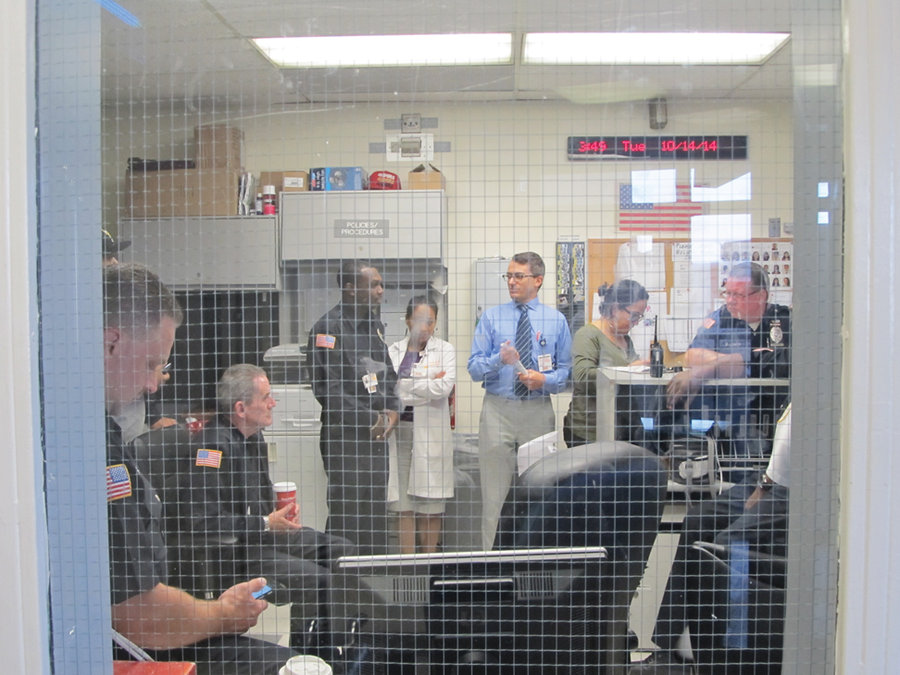Dr. Tucker Woods, chairman of the Department of Emergency Medicine, stood in the security office at Christ Hospital on Oct. 14 surrounded by men and women in uniform. He had just come from a meeting with top officials at CarePoint, and the Ebola outbreak in West Africa had been the chief topic.
“The nurse catching Ebola in Texas was a game changer,” Woods told the security guards, referring to the first of two confirmed cases in which the disease spread to people living in the United States. “Everybody is concerned.”
He said he wanted to talk to security because they often have first contact with patients coming into the hospital. He wanted to make them aware of what to do if someone says they’ve been exposed to Ebola.
Ebola virus disease (EVD) is a hemorrhagic virus fatal to about half the humans who contract it. The first outbreaks occurred in the tropical regions of Central Africa in 1976. The most recent and most severe outbreak in West Africa was reported last March with the most severely affected countries being Guinea, Sierra Leone and Liberia.
How the disease spreads
Ebola spreads among humans when a person comes into contact with blood or other bodily fluids that enters their body through mucous membranes or broken skin. A person can also get exposed by touching an object or surface which has bodily fluids from an Ebola patient.
Healthcare workers, Woods noted, are vulnerable because they often have close contact with patients and so protective gear must be used.
The incubation period from first contact to the start of symptoms can be anywhere from two to 21 days. But learning a patient’s travel history is important, Woods said.
People with Ebola are not contagious to others until they develop the symptoms. “The symptoms are just like the flu,” Woods said, and could initially include headache, muscle ache, overall weakness, vomiting, diarrhea, even bleeding.
Once the virus progresses, the patient can suffer high fever, fatigue, increased muscle pain, severe headache, and sore throat. This is followed by vomiting, diarrhea, rash, symptoms of impaired kidney and liver function, and in some cases, both internal and external bleeding.
Woods said Christ Hospital was reviewing its criteria even before the nurse incident in Texas, and recently did a test of procedures by sending someone to act out the role of a patient.
“The symptoms are just like the flu.” – Dr. Tucker Woods
____________
Most the time, a patient coming in with Ebola-like symptoms will likely be suffering from malaria, not Ebola, he said.
But if a patient has the symptoms and comes from a geographical hot spot for Ebola, the hospital has already established protocols for contagious diseases, including having all the necessary equipment to protect caregivers and keep the disease from being spread.
Woods said the hospital will conduct another review shortly, which will use a glowing chemical to test procedures for taking off safety gear – one way some believe the nurse caught the disease in Texas.
He said the outside of the suit will be treated with the glowing chemical and a special lamp will reveal if the virus was spread to the skin.
The hospital is also following the procedures recommended by the Department of Health and the Center for Disease Control, he said.
If someone matches the criteria for infection, that person will be placed in isolation.
Special kits containing all the safety gear for care of Ebola patients have been prepared so that caregivers can use it immediately, thus leaving less opportunity for infection.
Better communication is key
“We also have to have nursing staff talking directly to doctors,” he said. “It is not enough to simply check a box on a computer. Someone needs to tell the doctor that the patient has been in an area with an Ebola outbreak has been reported.”
He said that was one failure in the Texas situation that allowed an Ebola patient to be sent home. The doctors were unaware of the history of the patient, who was hospitalized later and eventually died.
But Woods also said that the outbreak affects nearly every part of hospital operations, from simple things like the pencil or pen used to sign the admission form to the cuffs used to check blood pressure. Hospital staff needs to be aware of every possible way the disease might be spread and find a solution to keep it contained, such as verbal permission rather than written, and using disposable blood pressure cuffs.
Hospital staffers need to be drilled in procedures so that it becomes routine. Upcoming drills will involve all the emergency room personnel who might come in contact with a patient.
Woods, however, said he wanted to dispel some of the myths associated with the disease. While it is contagious, it is not airborne the way measles and tuberculosis are. In other words, you generally can’t catch it sitting in the same room. But you can catch it if a person sneezes and you breathe in the liquid droplets.
People with Ebola also do not spread it until they actually show the symptoms. So that if you’ve had contact with someone before they showed signs of sickness, you’re likely not going to catch it.
As the Ebola outbreak continues, all three of CarePoint Health’s hospitals – the Bayonne Medical Center, Christ Hospital in Jersey City and Hoboken University Medical Center – will remain vigilant for any potential cases, according to a release issued by Carepoint.
Dr. Meika Roberson, Chief Medical Officer and Chief of Emergency Medicine at CarePoint Health at Hoboken University Medical Center, has extensive training and experience in Hospital Incident Management, Infection Control and Emergency Medicine. She has appeared as a medical correspondent on NBC Nightly News with features including: “The Flu and Pediatric Deaths,” “The Difference with the Flu this Season,” and “The Meningitis Outbreak at Princeton University.”
Al Sullivan may be reached at asullivan@hudsonreporter.com.
